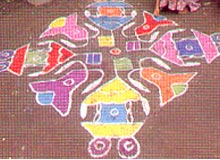 Aripana art form is a variation of the Rangoli, practiced in the Bihar. It usually comprises of line drawings, illustrated on the floor of the house. Aripana patterns are a part of each and every auspicious ceremony in Bihar, be it a puja, a vrata (fast) or a samskara (mundan, vivah, yajnopavita, etc). On the eve of a ceremony, Aripana designs are prepared in the courtyard, on the door front and a number of other places. Any ceremony or ritual is considered incomplete without this traditional art form adorning the ground.
Aripana art form is a variation of the Rangoli, practiced in the Bihar. It usually comprises of line drawings, illustrated on the floor of the house. Aripana patterns are a part of each and every auspicious ceremony in Bihar, be it a puja, a vrata (fast) or a samskara (mundan, vivah, yajnopavita, etc). On the eve of a ceremony, Aripana designs are prepared in the courtyard, on the door front and a number of other places. Any ceremony or ritual is considered incomplete without this traditional art form adorning the ground. Initially, Aripana designs were drawn in order to make the cultivated land fertile and fruitful by magical performances. However, today it has become a part of numerous ceremonies and rituals. While drawing Aripana, brushes are not used. Instead, nimble fingers are used to make the delicate designs. Aripana patterns are drawn with Pittha, powdered rice paste, made with the help of water. One may also make use of vermilion (sindur), along with white, red, green, yellow and black colors.
Aripana Designs
The designs or the motifs used in Aripana fall into the following five categories:
- Images of human beings, birds and animals
- Images of flower (lotus), leaves, trees and fruits
- Tantrik symbols, like yantras, bindu (dots), etc.
- Images of Gods and Goddesses
- Other objects like lamp, swastika, mountain, rivers, etc.
No comments:
Post a Comment